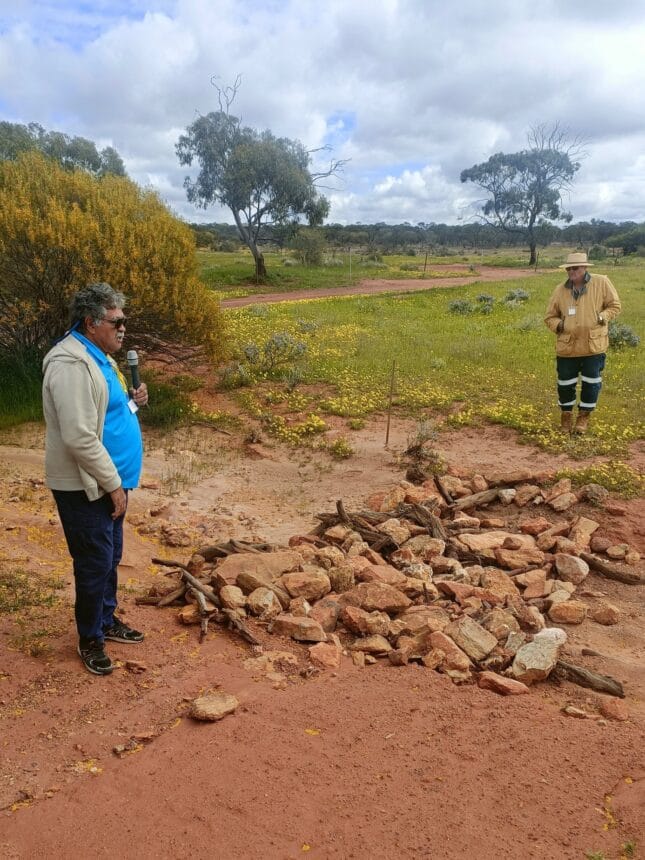
Under a soft, overcast sky in the Northern Wheatbelt, more than 60 people gathered on Badimia Country on Friday, 5 September for a field day that was as much about culture and connection as it was about soil and water.
The event, held across Gimlet Ridge and Weelhamby farms, marked an important milestone in the Transformative Aboriginal Agricultural Methods (TAAM) project, which brings together Aboriginal knowledge and Western science to build resilience in farming landscapes.
Led by Aboriginal researcher Clint Hansen of Maaman Marra Boodjar and Dave Blake from Edith Cowan University (ECU), the project is a collaboration between Maaman Marra Boodjar, ECU’s Centre for People, Place and Planet, and the Institute of Regenerative Leadership. The TAAM project is supported by South-West WA Drought Resilience Adoption and Innovation Hub, through funding from the Australian Government’s Future Drought Fund and the WA Agricultural Research Collaboration (WAARC).
WAARC Strategic Research Manager John Statton joined participants on the ground, noting the significance of the collaboration.
“This is not just about soil and water,” Dr Statton said.
“It’s about knowledge systems – Aboriginal and Western – coming together to build resilience in our agricultural landscapes.”
The morning began at Weelhamby Farm, where Mr Hansen welcomed participants and walked them through a site scarred by erosion.
Here, a series of leaky weirs, constructed from local rock, logs and woody debris, are being installed.
The structures are designed to slow water flow, reduce erosion, and allow moisture to seep back into the soil.
For Dr Blake, the project demonstrates the importance of grounding science in place.
“We’re measuring soil moisture, vegetation diversity, and erosion changes, but we’re also capturing stories, yarning, and cultural insights that are just as critical,” Dr Blake said.
From Weelhamby, the group moved upstream to Gimlet Ridge Farm, where landholder Rod Butler has been working with Mr Hansen since 2018 to integrate Aboriginal knowledge into his farming system.
Attendees stood beside a gully where stone and logs had been carefully placed, transforming a once-barren erosion channel into a site of renewal.
“Reading Country tells us where water wants to go,” Mr Hansen said.
“We’re not fighting the land; we’re watching and listening to it.”

For Mr Butler, the difference the approach has already made to his property is profound.
“It’s changed how we think about water, about soil, about stewardship,” Mr Butler said.
Participants also observed the suite of monitoring tools being applied to the project, from drone surveys to a soil sensor network that records changes across the seasons.
Importantly, this data is being collected in alignment with the Nyungar calendar, ensuring Aboriginal seasonal knowledge is embedded alongside scientific measurement.
The day was not only a technical exercise but also a cultural and educational exchange.
Attendees took part in yarning sessions, sharing experiences of land, water, and resilience.
Students from the Morawa Agricultural College joined in, learning firsthand how to read a landscape and how scientific data collection can sit alongside cultural knowledge.

Now in its third phase, the TAAM project is testing how Aboriginal methods and protocols can be adapted for use across the Wheatbelt and beyond.
For WAARC, it reflects a model of collaboration that extends well beyond traditional research frameworks.
“This is a model for future agriculture,” Dr Statton said.
“It’s collaborative, it’s respectful, and it’s deeply rooted in Country.”
As the group returned to Perenjori Town Hall to close the day, attention turned to early results.
Presentations covered soil samples, drone footage and recorded stories, before a panel discussion drew together the threads of culture, science, and community.
The overarching message was clear – connections had been forged, not only between people, but between knowledge systems and across generations.
For Mr Hansen, the field day was a beginning rather than an end.
“We’re building something that lasts,” he said.
“Not just in the soil, but in the spirit of how we care for Country.”



